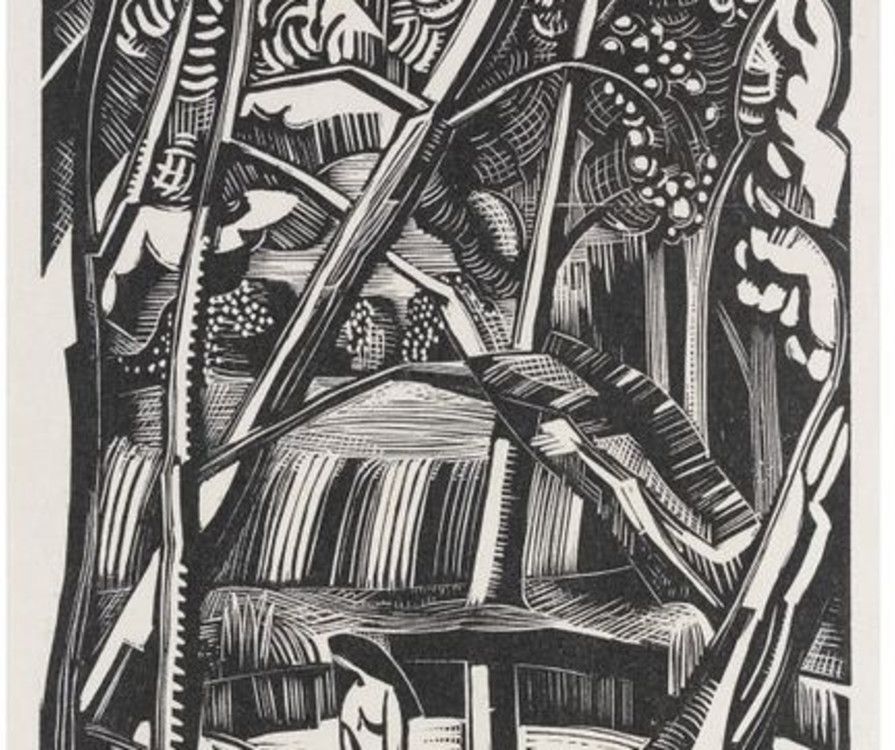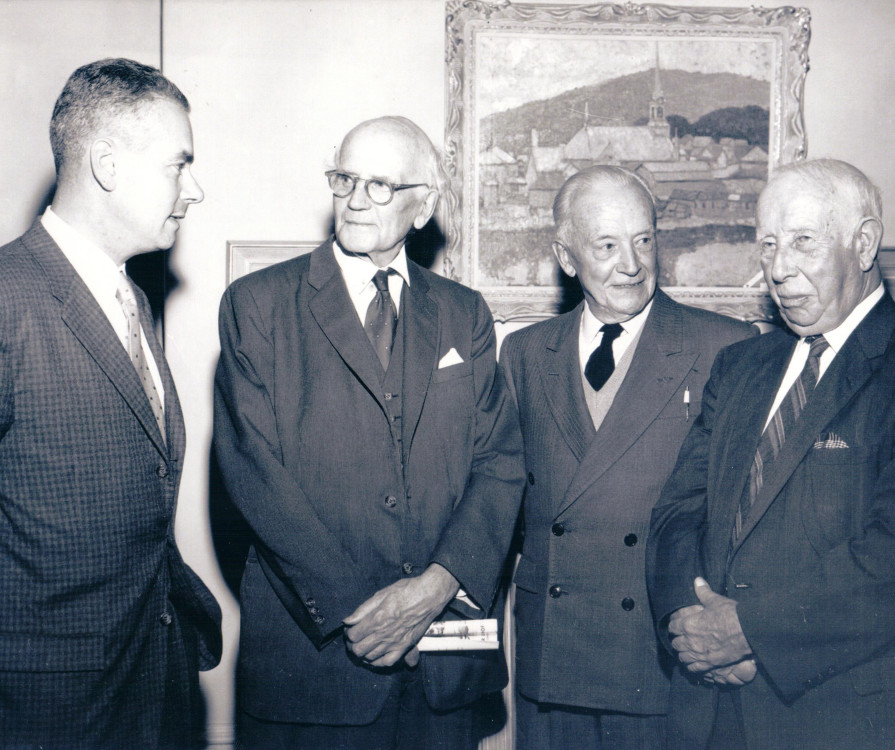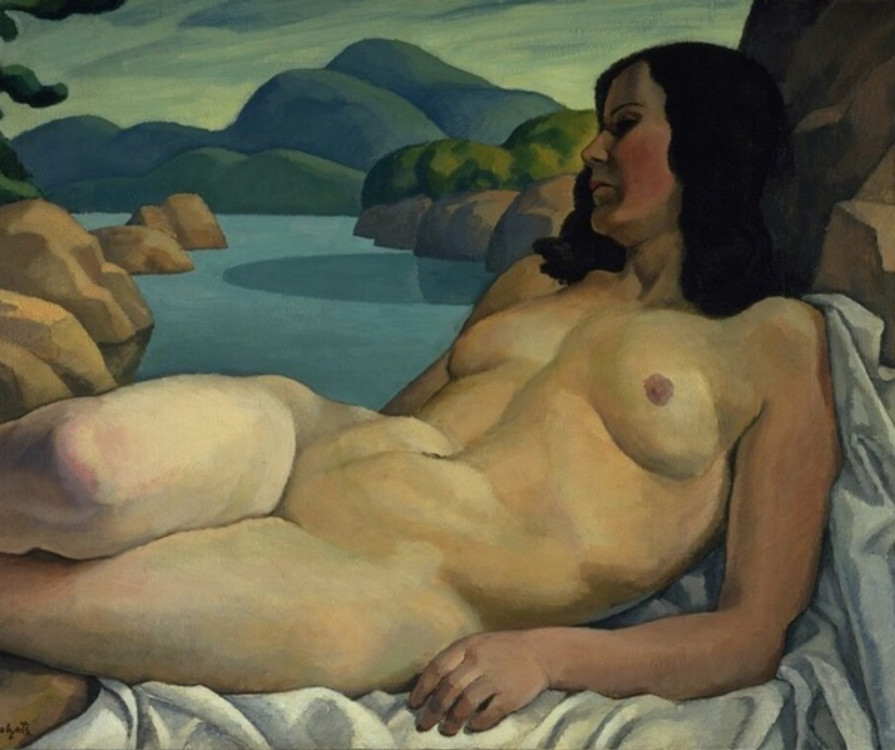One of Holgate's most striking images, "Nude by a Lake", c. 1933
Careful draughtsmanship and a profound knowledge of the clean modernist aesthetic led Edwin Holgate to be a central figure in the development of Canadian art in the 1920s and 1930s and to be what the National Gallery calls "instrumental in the revival of woodblock printing."1 Holgate recognized the capacity of wood engravings to represent splendid, three-dimensional forms. Nude by a Lake exhibits a judicious balance of detailed and broadly treated volumes and shows the precision possible in wood engraving.
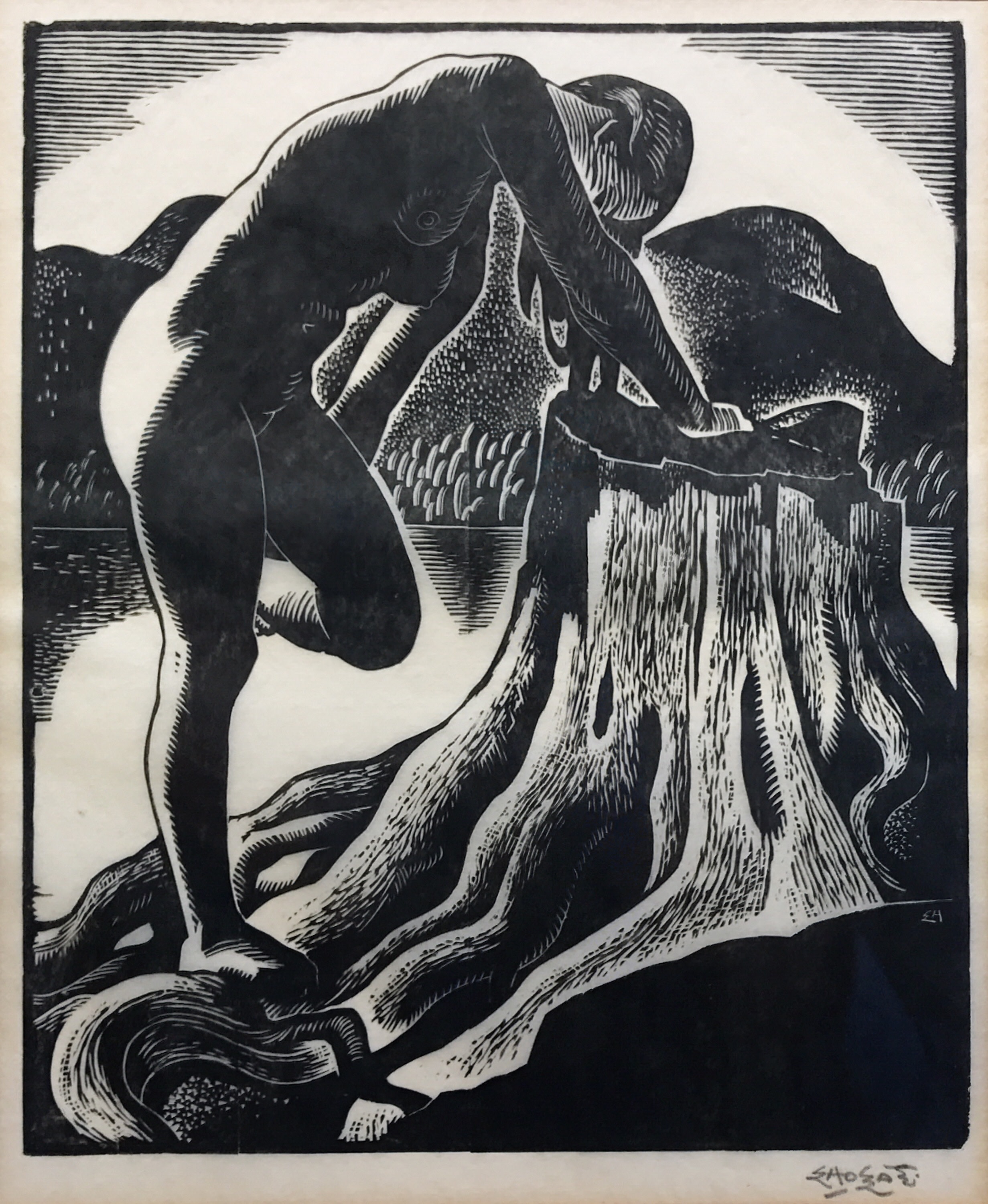
Fig. 1
Edwin Holgate, R.C.A. (1892-1977)
Nude by a Lake, c. 1933
Wood engraving, 8 1/2 x 6 1/2 in (21.6 x 16.5 cm)
signed in the block with artist's initials, "EH" (recto, mid-lower right);
signed in pencil, "E. Holgate." (recto, lower right margin).
Provenance
Walter Klinkhoff Gallery, Montreal, as Bather at Tree Stump;
Private collection, Westmount, Quebec.
SOLD
Holgate claims that he became attracted to woodblock printing in the early 1920s, upon his return to Paris following the war.2 In his 1973 interview, Charles C. Hill inquired of Holgate, "Can you think of anybody in particular that you were interested in, or impressed by, or you felt was important?"3 To which Holgate explained, "John and Paul Nash. And then there was a whole school of-English school of engraving, which was a very powerful school, a very powerful trend."4 The Nash brothers recognized wood engraving as a medium that was ideal "to depict the natural world as formed by the intersection of sharp-edged, geometrical extrusions through space [which] dislocated modernist prose [...]."5 Holgate himself commented that the English school were a "robust band of engravers who take second place to none" and that were "steadily working toward a purer expression in white line."6
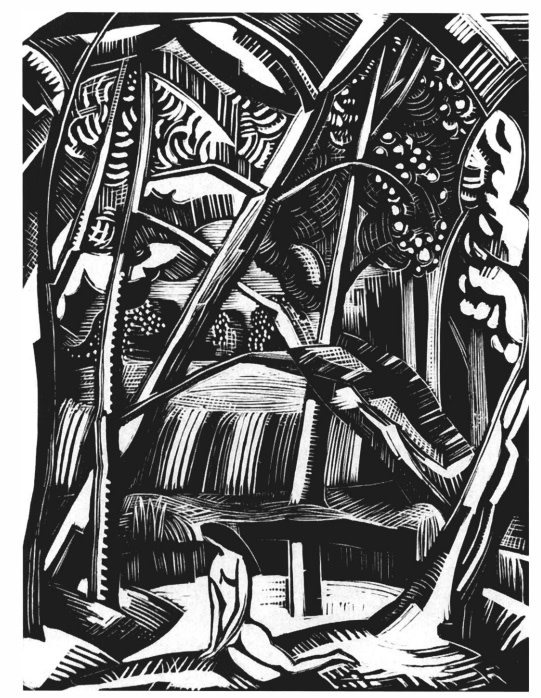
Fig. 2
Paul Nash, Black Poplar Pond, 1921, plate 2 from Places, wood engraving on paper, 15.2 x 11.4 cm
Armed with the English school's influence and vigour for printmaking to express the formal properties and attitudes of modernism, Holgate endeavoured to control the black-on-white and white-on-black interchanges that the wood engraving offered. Nude by a Lake, c. 1933 [Fig. 1] is amongst the most ambitious graphic works by Holgate in the medium. Ian Thom, author of the The Prints of Edwin Holgate, praised Nude by a Lake, heralding it "...an elegant image. Restrained in cutting, it is the work of an artist absolutely confident of his means. The print speaks quietly but eloquently, the variety of line giving gentle animation to a completely resolved composition."7
Thom notes that, at the time of his publication, there were seven known impressions of Nude by a Lake.8 He asserts the edition size to be "presumably 30" and that "[nos.] 35 and 41 are likely later impressions."9 In his Reminiscences of an Art Dealer, Walter Klinkhoff writes, "Holgate had some wonderful wood engravings [...] He could still make some prints within his limited edition and I bought them when I could."10
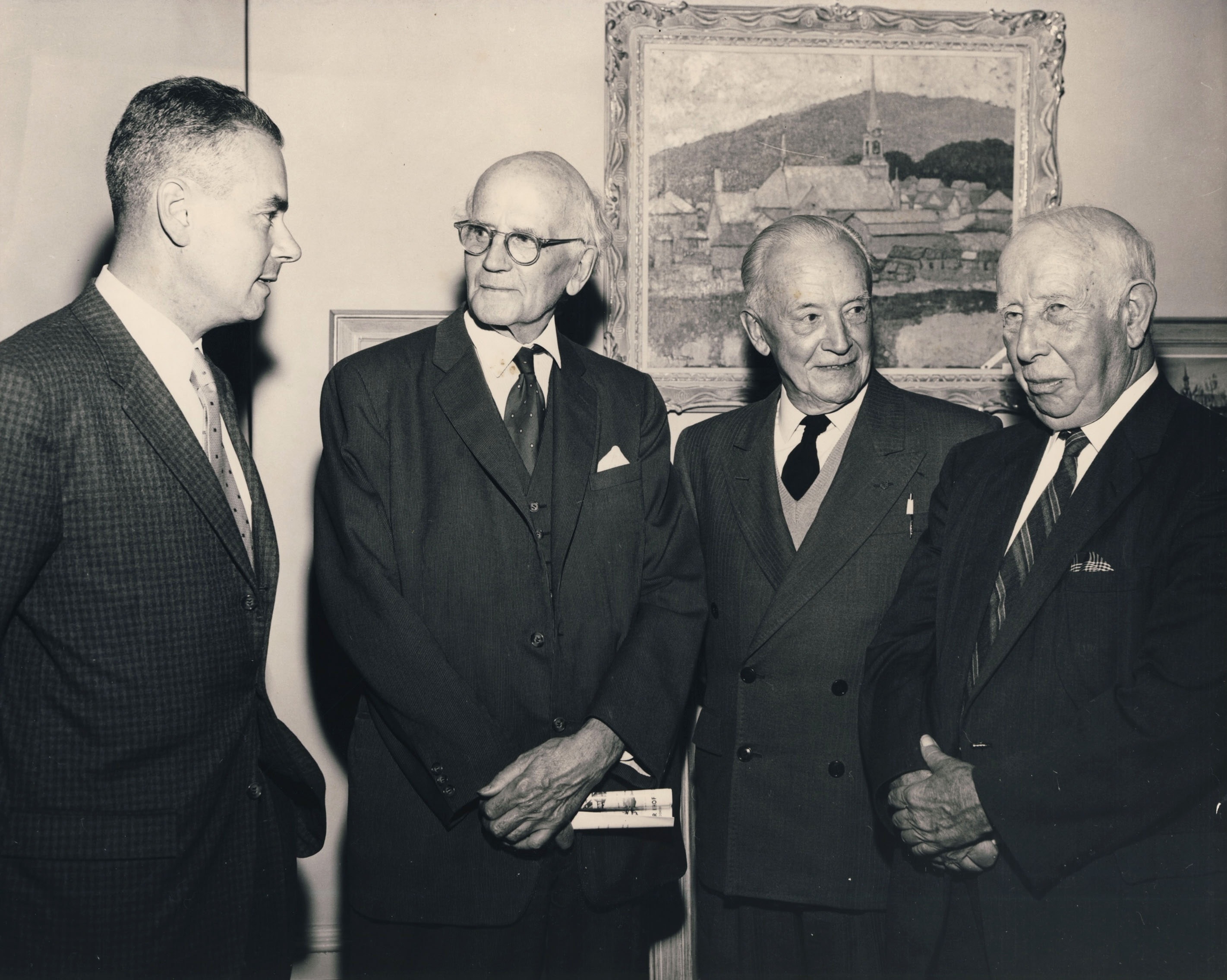
Fig. 3
Walter Klinkhoff, Arthur Lismer, Edwin Holgate, and A.Y. Jackson at the Randolph Hewton Retrospective at Walter Klinkhoff Gallery in October 1962
Walter Klinkhoff sold this specific impression to one of the gallery's foremost collectors of the early 1960s. The couple also purchased major canvases by James Wilson Morrice, Clarence Gagnon, and Maurice Cullen, to name only a few.11
Klinkhoff, in Reminiscences of an Art Dealer, continues, "Eventually he [Holgate] instructed me to give the wood blocks to the Museum as a gift and for study by students and artists."12 The block for Nude by a Lake is housed at the Montreal Museum of Fine Arts [Fig 4].
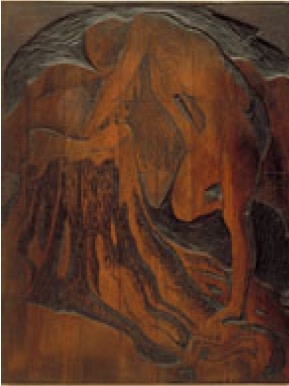
Fig. 4
Wood block for Nude by a Lake, Montreal Museum of Fine Arts, Inventory No. GR.1972.68b
In Nude by a Lake, Holgate cleverly manipulates the positive and negative spaces. For the left side of the figure Holgate leaves his block untouched so as to indicate the soft, fleshy skin of the bather. Finely incised lines on the right side of the nude establish that the figure stands with her back toward dazzling sunlight. The flickering lights and darks in the intricate network of the lines and stipples that describe the rough bark of the tree stump against which the figure rests are created by Holgate's adept handling of the graver. Holgate, Thom writes, "makes superb use of the undulating contours" to depict the gnarled roots of the stump.13
Holgate's mature sense of the medium can also be seen in his treatment of the water. The rhythmic repetition of horizontal black lines suggests a softly rippling tide that emerges from the broad, luminous expanse of water, created by the stark white of the pristine paper. This effect is mirrored in the sky to depict the glow of sunlight. The horizon line is brilliantly interrupted by the dense, velvety black of the hillside, whose grassy terrain is illustrated by slight, agitated flecks of the artist's tool.
Rosemarie Tovell, in the 2005 publication, Edwin Holgate, describes Nude by a Lake as "Holgate's most majestic wood engraving."14 Tovell also notes, "The masterful execution of this print and the monumental quality of the nude make it one of Holgate's most striking images."15
In 1933, Holgate submitted four works to the first international exhibition of contemporary woodblock prints in Warsaw, Poland, one of which was Nude by a Lake.16 In a Polish review by art critic Mieczysław Sterling, a sizeable reproduction of Holgate's Nude by a Lake introduces the article, selected from some 700 works [Fig. 5].17
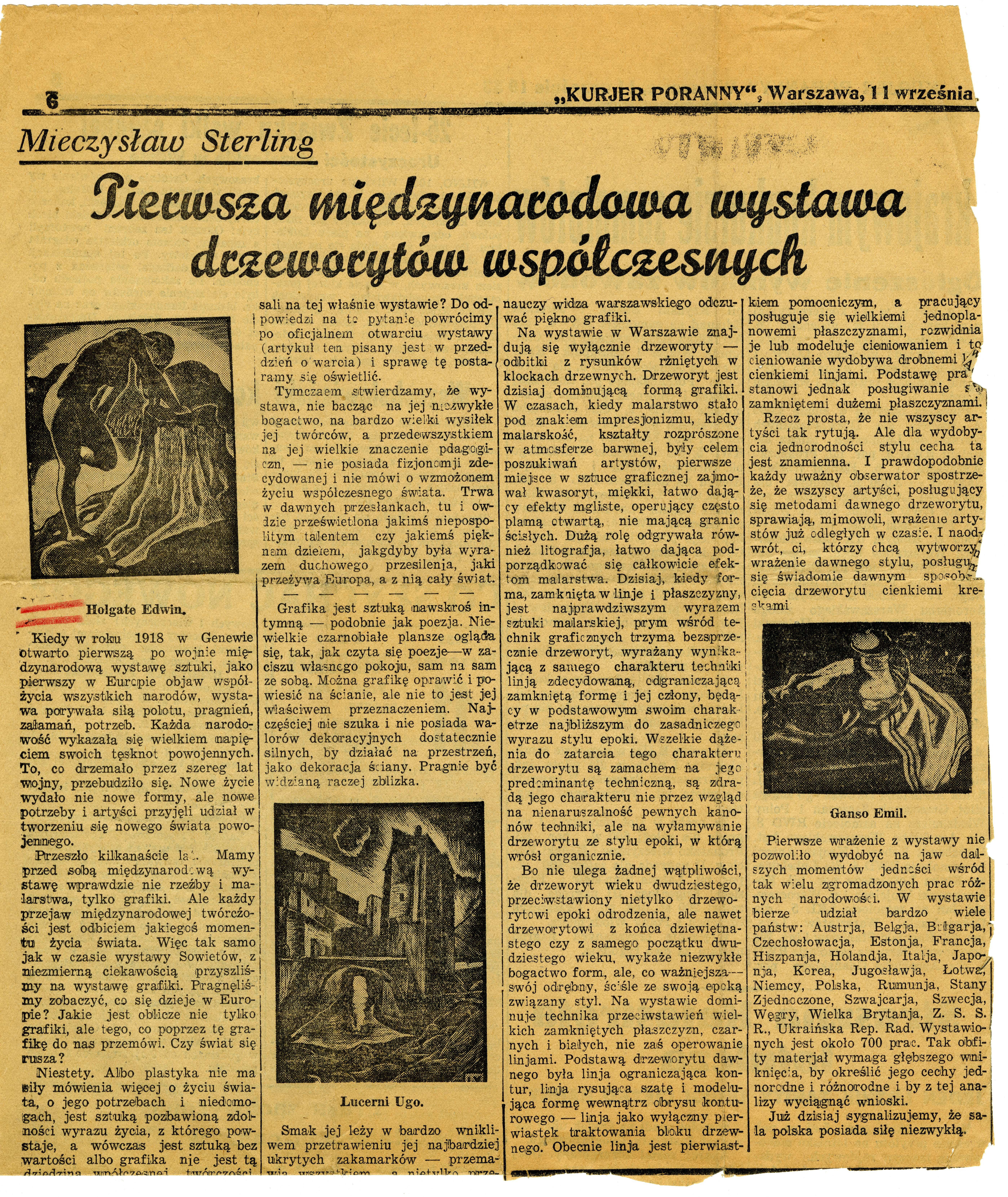
Fig. 5
Clipping of Mieczysław Sterling's "Pierwsza międzynarodowa wystawa drzeworytów współczesnych" from Kurjer Poranny, (Warsaw, Poland), 11 September 1933
In his own publication, Some Comments on Wood Engraving in Canada, the print Nude by a Lake was likeswise chosen as the frontispiece for Holgate's article [Fig. 6].18 In his column, Holgate writes,
What are the qualities which particularly distinguish the wood engraving from other media of graphic arts? With a material whose very hardness offers resistance to the cutting tools, the nervous line is a perforce eliminated and a more rigid and calculated line results. The element of hazard and accidental effect, interesting some other media - notably with certain types of etching - is missing. But its very directness of statement - its crisp whites and rich blacks - give the woodcut19 a luminous quality that lends itself to bold design, a dramatic intensity which no other medium possesses, to the same degree.20
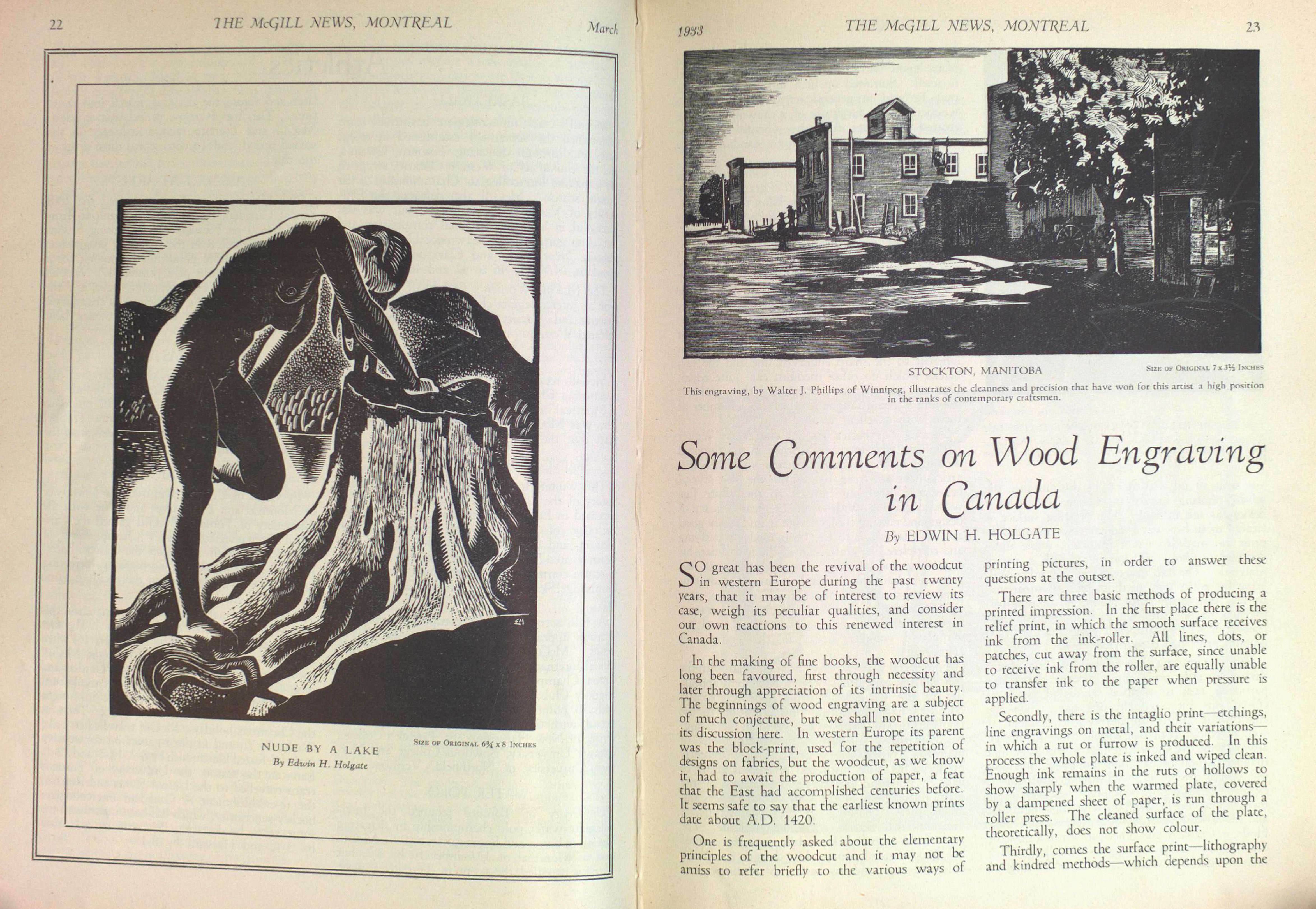
Fig. 6
Pages 22 and 23 from McGill News with part of Holgate's article and its introductory illustration, Nude by a Lake
The choice to use Nude by a Lake to illustrate what the artist refers to as a medium that has "long been favoured … for its intrinsic beauty" suggests that Holgate himself held the print in high regard.21 This notion that Holgate favoured this print above others is further evidenced by its $10.00 asking price - the most expensive of his wood engravings - during the 1933 show, Exhibition of Paintings and Wood-cuts by Edwin H. Holgate [Fig. 7].22 A contemporary review in the Toronto Daily Star of Holgate's 1933 exhibition at the Art Association of Montreal reads, "The exhibition includes sketches and small pictures in oil, drawings and prints. Among the woodcuts [sic], though they are very few in number, there is some of the best work in the collection. There are beautiful drawing, line and composition in the 'Nude by Lake [sic],' which is one of the larger ones [...]."23
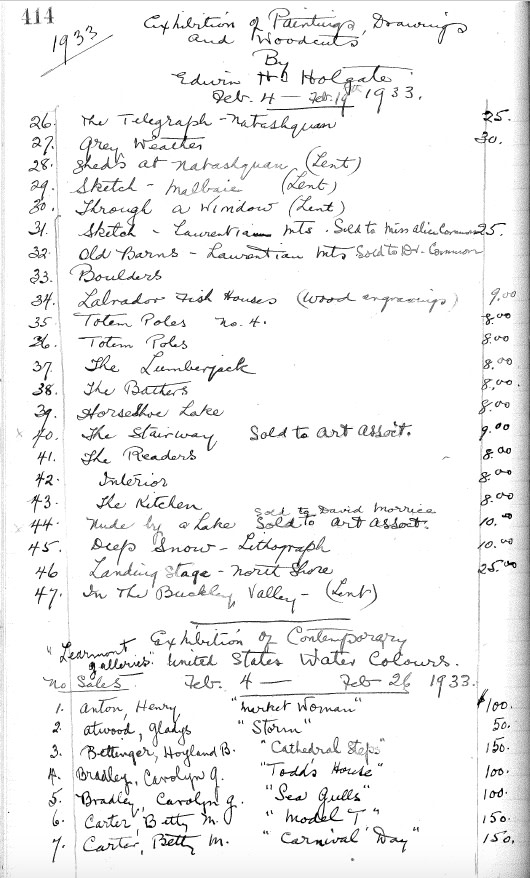
Fig. 7
Exhibition Registry from Exhibition of Paintings and Wood-cuts by Edwin H. Holgate, held at the Art Association of Montreal, 4-19 February 1933.
Amongst Holgate's most celebrated works are his monumental nudes in the landscapes from the 1930s, including the National Gallery of Canada's Nude in a Landscape and Early Autumn [Fig. 8 & 9 ].24 In Nude in a Landscape one notes the same rounded rocks and hills that can be found in the background in the Nude by a Lake. In Early Autumn, Holgate's Royal Canadian Academy of Arts diploma work, the nude is depicted in a similar open air setting as that of the wood engraving. Both figures are posed in such a way that we, the spectator, have seemingly discovered them in the midst of bathing and both contort so that they turn slightly away and are seemingly unaware of our intrusion.
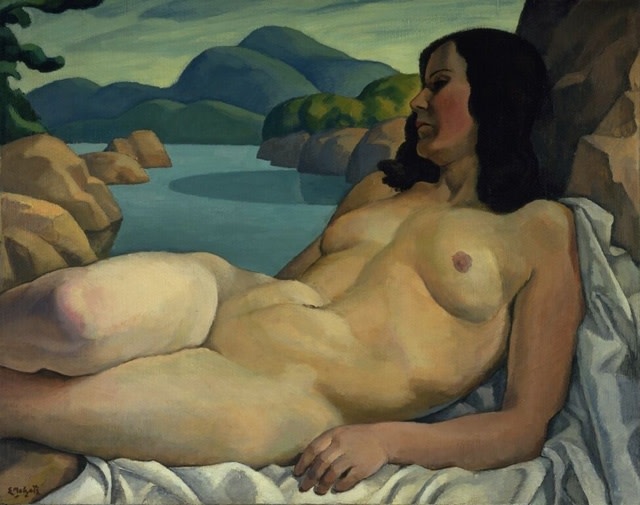
Fig. 8
Edwin Holgate, Nude in a Landscape, c. 1930, Oil on canvas, 73.1 x 92.3 cm, National Gallery of Canada, Accession No. 3702
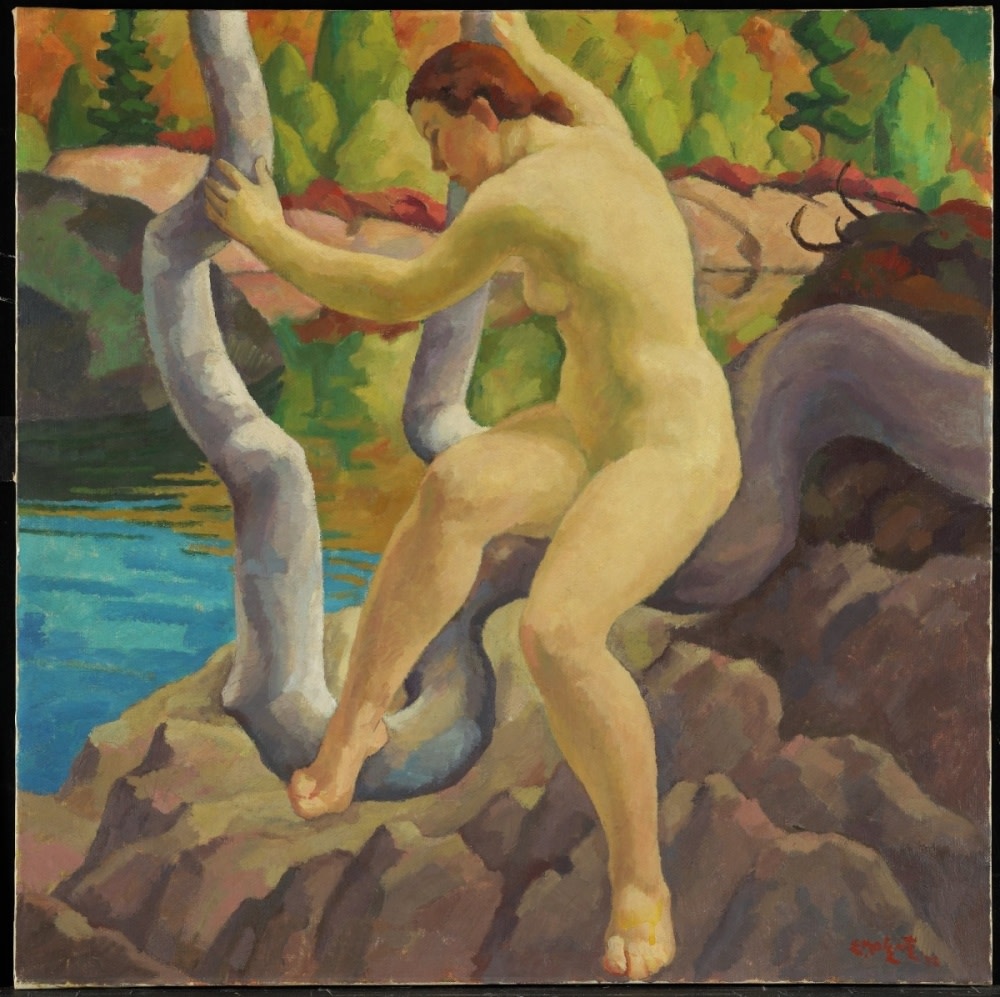
Fig. 9
Edwin Holgate, Early Autumn, 1938, Oil on canvas, 72.5 x 72.5 cm, National Gallery of Canada, Accession No. 4355
The prints of Edwin Holgate were much admired by fellow artists. As editor, J.E.H. MacDonald selected a number of Holgate's woodcuts to illustrate articles in Canadian Forum.25 Other artists and important scholars, such as Adrien Hébert and Marius Barbeau, owned Holgate's prints. 26 27 Despite his limited output, his artistic production in the medium virtually stopped after the 1930s, the breadth and lyricism of his wood engravings situate Holgate as one of the leading printmakers in Canada.28 The present Nude by a Lake [Fig. 1]- with its striking balance of contrasting of black and white and sweeping curves and linearity - is a richly inked example of the skillful renditions that Holgate achieved as a wood engraver.
Alan Klinkhoff Gallery would like to extend thanks to Ms. Audrey Marcoux of the Montreal Museum of Fine Arts Archives, Ms. Jennifer Nicoll, Collections Manager / Exhibition Coordinator at the Agnes Etherington Art Centre, and Mr. Nicholas Pullen, Graduate Teaching Assistant at McGill University.
EXTERNAL IMAGES CITED
Fig. 2.
Paul Nash, Black Poplar Pond, 1921, plate 2 from Places, wood engraving on paper, 15.2 cm x 11.4 cm, reproduced in David Peters Corbett, "'The Third Factor': Modernity and the Absent City in the Work of Paul Nash, 1919-36." The Art Bulletin 74, no. 3 (1992), p. 464, fig. no. 2.
Fig. 3
Walter Klinkhoff, Arthur Lismer, Edwin Holgate, and A.Y. Jackson at the Randolph Hewton Retrospective at Walter Klinkhoff Gallery in October 1962, Courtesy of Alan Klinkhoff, Alan Klinkhoff Gallery
Fig. 4
Wood block for Nude by a Lake, Montreal Museum of Fine Arts, Inventory No. GR.1972.68b, Courtesy of Ms. Audrey Marcoux, Archives
Fig. 5
Clipping of Mieczysław Sterling's "Pierwsza międzynarodowa wystawa drzeworytów współczesnych" from Kurjer Poranny, (Warsaw, Poland), 11 September 1933, Agnes Etherington Art Centre, Queen's University, Kingston, Ontario, Edwin Holgate Fonds, Scrapbook 4, no. 2-047.164, EH4, Courtesy of Ms. Jennifer Nicoll, Collections Manager / Exhibition Coordinator
Fig. 6
Pages 22 and 23 from McGill News from Edwin Holgate, "Some Comments on Wood Engraving in Canada", McGill News,
Vol. 14, (March 1933), p. 22-26
Fig. 7
Exhibition Registry from Exhibition of Paintings and Wood-cuts by Edwin H. Holgate, held at the Art Association of Montreal, 4-19 February 1933, ref. no. unknown, Courtesy of Ms. Audrey Marcoux, Archives, Montreal Museum of Fine Arts
Fig. 8
Edwin Holgate, Nude in a Landscape, c. 1930, Oil on canvas, 73.1 x 92.3 cm, National Gallery of Canada, Ottawa, Ontario, Purchased 1930, Accession No. 3702
Fig. 9
Edwin Holgate, Early Autumn, 1938, Oil on canvas, 72.5 x 72.5 cm, National Gallery of Canada, Ottawa, Ontario, Royal Canadian Academy of Arts diploma work, deposited by the artist, Montreal, 1939, Accession No. 4355
ENDNOTES
1. National Gallery of Canada, Edwin Holgate, n.d., https://www.gallery.ca/collection/artist/edwin-holgate
2. Rosemarie Tovell, "'Crisp Whites and Rich Black': The Wood Engravings", Edwin Holgate, (Montreal: The Montreal Museum of Fine Arts, 2005), p. 68
3. Charles Hill Interview with Edwin Holgate, Charles Hill / Edwin Holgate, 20 September 1973, National Gallery of Canada, p. 33
4. Ibid.
5. David Peters Corbett, "'Third Factor': Modernity and the Absent City in the Work of Paul Nash, 1919-36.", The Art Bulletin 74, no. 3 (1992), p. 461
6. Edwin Holgate, "Some Comments on Wood Engraving in Canada", McGill News, Vol. 14, (March 1933), p. 24, Courtesy of Mr. Nicholas Pullen, Graduate Teaching Assistant, McGill University
7. Ian Thom, The Prints of Edwin Holgate, (Kleinburg, ON: McMichael Canadian Art Collection, 1989), unpaginated
8. Ibid., Thom describes the works as "MMFA (13/30, 11/30, no. 41); Private Collection (no. 35, 20/30); Robert McLaughlin (6/30 [as Nude by a Stump])." Notably, there are additional impressions now held at the Glenbow Museum, The Beaverbrook, and the National Gallery of Canada.
9. Ian Thom, 1989, cat. No 47, unpaginated
10. Walter H. Klinkhoff, Reminiscences of an Art Dealer, (Montreal: Walter Klinkhoff Gallery, 1993), p. 9
11. Alan Klinkhoff, Alan Klinkhoff Gallery, to Author, 25 April 2018
12. Walter Klinkhoff, 1993, p. 9
13. Ian Thom, 1989, unpaginated
14. Tovell, 2005, p. 73
15. Ibid., p. 71
16. Ibid., p. 76
17. Mieczysław Sterling, "Pierwsza międzynarodowa wystawa drzeworytów współczesnych" from Kurjer Poranny (Warsaw, Poland), 11 September 1933, Courtesy of Jennifer Nicoll, Collections Manager / Exhibition Coordinator, Agnes Etherington Art Centre, Queen's University, Kingston, Ontario, Edwin Holgate Fonds, Scrapbook 4, no. 2-047.164, EH4
18. Holgate, 1933, reproduced p. 22
19. N.B.: Holgate often interchanges the terms "wood engraving" and "woodcut." Tovell makes a similar observation on the artist's confounding of the terms, see: Tovell, 2005, p. 77, endnote 4
20. Holgate, 1933, p. 25-6
21. Ibid., p. 23
22. Art Association of Montreal, Exhibition of Paintings and Wood-cuts by Edwin H. Holgate, 4-19 February 1933
23. "Edwin Holgate's Prints and Pictures" Toronto Daily Star (Toronto, Ontario), 8 February 1933
24. Sarah Milroy, "Holgate's Two Solitudes", The Globe and Mail, 9 June 2005,
25. Tovell, 2005, p. 76
26. Ibid.
27. Marius Barbeau to Edwin Holgate, 15 February 1927, Canadian Museum of History, Marius Barbeau Fonds, Correspondence, Edwin Holgate (1926-1940), B204, f.19., Barbeau writes, "It was too kind of you to have given me another wood cut engraving, a splendid example of your art."
28. Tovell, 2005, p. 76




